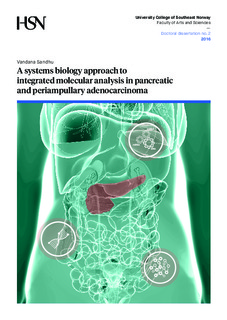| dc.contributor.author | Sandhu, Vandana | |
| dc.date.accessioned | 2018-02-16T10:04:13Z | |
| dc.date.available | 2018-02-16T10:04:13Z | |
| dc.date.issued | 2016-04-13 | |
| dc.identifier.isbn | 978-82-7206-408-1 | |
| dc.identifier.issn | 2464-2843 | |
| dc.identifier.uri | http://hdl.handle.net/11250/2485302 | |
| dc.description.abstract | Pancreatic and periampullary adenocarcinoma (PA) is a highly lethal disease, for which the mortality rate closely parallels the incidence rate. Most of the PA patients remain asymptomatic until the disease reaches an advanced stage with an overall survival of <5%. More than 85% of patients are unressectable due to locally advanced or metastatic disease at time of diagnosis.
There are no early diagnostic or good prognostic markers of pancreatic cancer. Most PA arise from microscopic non-invasive epithelial proliferations within the pancreatic ducts, referred to as pancreatic intraepithelial neoplasia and less frequently from other benign lesions like Intraductal papillary mucinous neoplasm and mucinous cystic neoplasm. Surgical resection is regarded as the only potentially curative treatment. The studies of PA have suggested structural variations and mutations in KRAS, SMAD4, CDKN2A and TP53 as the major driver events. However, the overall prevalence of genetic events is highly variable between PA from different patients.
The overall goal of this thesis is to gain insight into the molecular mechanisms of PA using a system biology approach. The miRNA and mRNA expression profiling of 85 PA tissue samples stratified the patients based on the morphological subtypes pancreatobiliary and intestinal. The study identified deregulated pathways and potential prognostic markers between the two morphological subtypes. Copy number aberration analysis of 60 PA samples also identified differences between the morphological subtypes. By integrating transcriptomic and genomic data we identified driver genes and pathways in PA. The integration of multiple –omics data takes into account cross talk at multiple levels in complex networks, and elucidate the variations that single –omics data cannot explain. Further, the transcriptome and genome profiles of three xenograft cell lines were compared to the original tumor they were derived from. The xenografts cell lines and original tumors had similar morphology, degree of differentiation, and genomic and transcriptomic profiles. The similarities suggest that the xenograft cell line can be use as in vitro models for studying the disease.
The main characteristic of PA is the abundant desmoplastic stroma, which is involved in the aggressiveness of the disease. The role of miRNAs in 20 pancreatobiliary PA, the more aggressive subtype was deciphered. miRNAs were found to have a role in facilitating tumor stroma interactions by regulating the pathways involved in tumor stroma interaction.
This research identifies important driver genes, miRNAs and commonly aberrated genomic loci in PA of prognostic relevance. The identified intercalated network of information from the analyzed –omics data contribute to the current knowledge of the molecular biology of pancreatic and periampullary adenocarcinoma. | nb_NO |
| dc.language.iso | eng | nb_NO |
| dc.publisher | University College of Southeast Norway | nb_NO |
| dc.relation.ispartofseries | Doctoral dissertations at the University College of Southeast Norway;2 | |
| dc.relation.haspart | Paper I: Sandhu V., Bowitz Lothe I.M., Labori K.J., Lingjaerde O.C., Buanes T., Dalsgaard A.M., Skrede M.L., Hamfjord J., Haaland T., Eide T.J., Borresen-Dale A.L., Ikdahl T. & Kure E.H.: Molecular signatures of mRNAs and miRNAs as prognostic biomarkers in pancreatobiliary and intestinal types of periampullary adenocarcinomas. Molecular Oncology, 9(4), (2015). 758-771. http://dx.doi.org/10.1016/j.molonc.2014.12.002 | nb_NO |
| dc.relation.haspart | Paper II: Sandhu V., Bowitz Lothe I.M., Labori K.J., Skrede M.L., Hamfjord J., Dalsgaard A.M., Buanes T., Dube G., Kale M.M., Sawant S., Kulkarni-Kale U., Børresen-Dale A.L., Lingjærde O.C., Kure E.H.: Differential expression of miRNAs in pancreatobiliary type of periampullary adenocarcinoma and its associated stroma. Molecular Oncology 10(2), (2015). 303-316. http://dx.doi.org/10.1016/j.molonc.2015.10.011 | nb_NO |
| dc.relation.haspart | Paper III: Sandhu V., Wedge D.C., Bowitz Lothe I.M., Labori K.J., Dentro S., Buanes T., Skrede M.L., Dalsgaard A.M., Lingjærde O.C., Børresen-Dale A.L., Ikdahl T., Van Loo P., Nord S., Kure, E.H.: The genomic landscape of pancreatic and periampullary adenocarcinoma. Manuscript. Published in Cancer Research 76(17), (2015). 5092-5102. http://dx.doi.org/10.1158/0008-5472.CAN-16-0658 | nb_NO |
| dc.relation.haspart | Paper IV: Wennerstrom A.B., Bowitz Lothe I.M., Sandhu V., Kure E.H., Myklebost O. & Munthe E.: Generation and characterization of novel pancreatic adenocarcinoma xenograft models and corresponding primary cell lines. PLoS One 9(2014), e103873. http://dx.doi.org/10.1371/journal.pone.0103873 | nb_NO |
| dc.rights.uri | http://creativecommons.org/licenses/by-nc-sa/4.0/deed.no | |
| dc.subject | pancreatic adenocarcinoma | nb_NO |
| dc.subject | periampullary adenocarcinoma | nb_NO |
| dc.subject | pancreatic cancer | nb_NO |
| dc.title | A systems biology approach to integrated molecular analysis in pancreatic and periampullary adenocarcinoma | nb_NO |
| dc.type | Doctoral thesis | nb_NO |
| dc.description.version | publishedVersion | nb_NO |
| dc.rights.holder | © 2016 Vandana Sandhu, except otherwise stated | nb_NO |
| dc.subject.nsi | VDP::Medisinske Fag: 700::Klinisk medisinske fag: 750::Onkologi: 762 | nb_NO |

